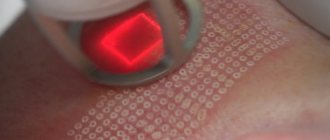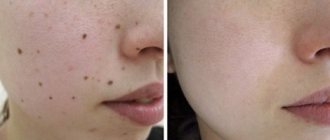What consequences can occur after mole removal?
What to do
if the removed mole starts to grow again?
These and other questions about the recurrence of nevi are answered by a specialist - Sergey Aleksandrovich Tverezovsky, oncologist surgeon, candidate of medical sciences, mammologist, oncodermatologist, doctor of the highest category.
When removing moles or other skin growths, the doctor always explains to the patient the preferred method of removal and its feasibility.
Excision of a mole with a scalpel along with a flap of skin is used extremely rarely - if the nevus has a large base area (exceeds 2.5 cm) or if there is relative doubt about its benignity. In the remaining 90-95% of cases of mole removal, the oncodermatologist uses laser or radio wave methods, or a combination of both.
What problems might the patient encounter?
Classification of moles:
1. Moles of epidermal origin (borderline, mixed, intradermal).
2. Moles of dermal origin (the most common representative is the blue nevus).
3. Combined moles.
4. High-risk moles (congenital and dysplastic nevi).
The most common type of moles are intradermal nevi - in appearance they are dome-shaped or papillomatous formations, from light brown to black in color, in some cases they can be reddish or whitish.
You can ask any questions you may have, sign up for a tumor removal procedure, or have a free consultation with a specialist by phone:
Sign up
Moles on the back - before surgery. Dermatoscopy:
Doctor: Grishko R.V.
Removal and treatment of moles with laser
After laser removal of a mole and to achieve the best cosmetic result until the wound heals, it is recommended to follow these recommendations:
- Avoid UV rays (and when unavoidable, use sunscreen with at least SPF 30, preferably SPF50). If the patient tans during healing, there is a high likelihood of post-inflammatory pigmentation, which can make the area where the procedure was performed more visible;
- Do not go to solariums, saunas, swimming pools, or engage in vigorous physical exercise (to avoid infections and injuries).
- As the wound heals, dry scabs form and act as a natural dressing to prevent infection. These scabs should not be scratched or otherwise torn off - wait until they fall off on their own.
During the procedures prescribed by the doctor - disinfection and dressing - the wound heals well and no infectious (or other complications) arise. Once the wound has healed, redness persists and sometimes it takes 1 to 2 months for the area of skin to reach its final appearance after the procedure. If the initial scabs have fallen off and there is an increased risk of scarring, a special scar treatment cream can be applied.
The main measures that are recommended for the treatment of scars formed after laser mole removal are as follows:
- Special purpose creams with silicone and so on.
- Special patches with silicone.
Silicone patch for scar treatment
Indications for removal of moles (nevi):
1. Cosmetic.
2. The presence of constant irritation of a mole (location on the neck, chest, waist area, scalp, perineum). Removal of moles on the palms, soles, and genitals is mandatory. Undesirable effects on moles are also tanning, solarium, trauma during massage, washing, or haircut. It is unacceptable to pull hair out of a mole - if you are not tired of the sight of a “hairy” mole, it should be removed.
3. Atypical appearance of the mole (intense and/or uneven pigmentation, irregular and poorly defined borders, large sizes (more than 10 mm), asymmetrical shape, as well as similar changes and rapid growth of the mole, the appearance of a pigment corolla around, inflammation and itching, erosion and bleeding).
4. Congenital nevi.
The above points are the reason for a mandatory examination and diagnosis of the mole by a dermato-oncologist, who will determine further tactics.
Removal of moles on the back immediately after surgery: Doctor: Grishko R.V.
I would also like to refute the common myth about the inviolability of moles, because... Only removal of the formation followed by histological examination is a guarantee of your health.
FAQ
Today, the “gold standard” is the removal of moles using an ablative laser.
The CO2 laser used in the clinic has the following advantages:
- Thanks to the small thickness of the beam (200 µm), it is possible to precisely influence the tissue;
- The procedure for removing a mole is radical and one-time;
- Lack of direct contact of the device with the wound, asepsis, hemostasis (the wound does not bleed);
- Favorable effect on regeneration, rapid wound healing, virtually no scar.
How are moles removed with laser?
The content of the article
The procedure is carried out under local anesthesia - before removing the mole, the doctor administers local analgesics. The effect of the drug lasts from half an hour to 3 hours. After the procedure, a wound remains, which, depending on the size and location of the removed mole, heals in 2-4 weeks.
After the procedure for removing the bandage, the doctor writes a prescription for an ointment, which must be used at home until healing. This prevents infection and provides a beautiful aesthetic appearance and helps prevent scarring. Depending on the size and location of the mole, the procedure takes 10-15 minutes, and several moles can be removed in one visit.
The laser, which is used to remove moles or other skin lesions, works on the principle of evaporating water from cells. This means that water evaporates from the affected cells and the cells die, while the surrounding tissue remains intact. True, in some cases, a post-procedure wound on the skin caused by heating may seem deeper than it actually is, but after a few days everything returns to normal, and the skin defect fills in during the healing period and leaves a small spot.
The effect of laser on moles
The surgical laser used for mole removal (and other soft tissue procedures) is highly accurate and is by far the best choice for this type of procedure.
Laser removal of tumors. Possible complications after the procedure
After surgery, you need to carefully monitor the operated area of skin.
Because after surgery, symptoms may appear that require immediate medical attention or additional treatment.
Symptoms:
- Itching, excessive wetting of the wound.
- Bleeding from the wound.
- Heat.
- Pus is released.
- Skin inflammation lasting several days.
Laser removal of tumors. Consequences
It happens that the healing process has slight deviations from the norm, but they can be eliminated with additional treatment.
Let's consider the possible consequences:
- Small blisters on the area of skin where surgery was performed. Occurs when exposed to particularly sensitive skin. Over time, the blisters are replaced by barely noticeable scars.
- The occurrence of hypopigmentation - a light spot forms at the site where the neoplasm was located. Such a defect is a consequence if the removal of the tumor somehow affected the deep layers of the skin and if the rule of prohibiting visiting a solarium and prolonged exposure to the sun is neglected. The white spot will disappear on its own within two years.
- Recurrence of nevus (moles/papillomas). This situation is possible if laser removal of a tumor is performed by an inexperienced specialist and the papilloma/mole is not completely removed. Do not be afraid, this case does not cause harm to health. If the tumor reappears, it can be removed again.
- If the patient has diseases such as herpes and acne, then activation of inflammatory processes is possible.
- The appearance of a depression at the site where the removal was carried out. The situation arises due to the low rate of tissue restoration. The scar is barely noticeable and does not require intervention, since it smoothes out on its own over time.
- The appearance of a bulge at the site where the removal was performed, darker in color than the skin at the site. If this phenomenon does not smooth out within six months, then you need to consult your doctor.
How to care for a wound after cauterization
After laser removal, the scab is dense and dry; it tightly covers the damaged tissue from bacteria and other substances. Often, dermatologists simply ask not to touch the cauterization area, and not to treat it with anything. Wear natural fabrics to allow air to flow freely to this area, as the healing process in the open air is much faster. Also, for the first week, do not wet the area too much so that the sore does not get wet.
If the damage is localized in hard-to-reach and ventilated areas, it is additionally recommended:
- To reduce pressure on the cauterized area on the foot, wear loose shoes and use special orthopedic gel protectors;
- After removal, treat the mucous membranes with antiseptics (chlorhexidine, miramistin) 2 times a day;
- If the wound gets wet, it is dried with flucarcin for the first three days.
A scar appeared after mole removal
When excision with a scalpel, modern, atraumatic absorbable suture materials are used to eliminate a wound defect and, often, the patient cares for the wound independently.
In this case, the scars remain as aesthetically pleasing and delicate as possible, but nevertheless they are still scars. After removing a mole with a laser or electrocoagulator, the marks are usually invisible on the body (when nevi up to 5 mm are removed), or are visible, but are perceived not as scars and scars, but as minor changes in the skin (there are no associations with surgical procedures).
The appearance of a scar after mole removal depends on the properties of the patient’s skin, the size of the lesion being removed, its location, the duration of healing, and the characteristics of caring for the wound during healing.
The most unpleasant moment is the appearance of a keloid scar at the site of the removed nevus - this is a frequent reason for repeated visits and many questions. A keloid scar after removal of a mole occurs due to the predisposition of the patient’s skin, in certain areas of the body (sternum area, for example), when complications arise in the form of suppuration of the wound, or during prolonged healing due to improper care of the wound.
A keloid scar can be disturbing not only due to its sloppy appearance, but also due to pain or severe itching.
Modern technologies make it possible to correct a keloid scar. For example, we use injection correction in combination with surface laser resurfacing. If treated in a timely manner, one procedure is sufficient.
Myth #3. “Removing moles costs a lot of money”
Now on the Internet you can find a variety of prices for this service - from several hundred to tens of thousands of rubles. However, on average, the price for removing one mole in St. Petersburg with histology is about 3-5 thousand.
On the one hand, this is a really significant amount.
From another point of view, every month we leave significantly more money in stores and gas stations. However, you will have to buy food and gasoline for the rest of your life, and after professional removal, moles will no longer appear. You will no longer have to think about how to avoid touching them with clothes, how to protect them from the sun, and whether they have signs of cancer or melanoma.
Don't skimp on your health:
3-5 thousand is not small money. However, they allow you to solve the problem of moles forever, safely and beautifully.
Contraindication for laser treatment
- Oncological diseases, HIV, AIDS, viral hepatitis.
- Chronic diseases in the acute stage.
- Pregnancy and lactation period.
- Infectious and inflammatory diseases.
- Organ failure.
- Severe diseases of the cardiovascular system, diabetes.
- Mental illnesses.
In medical operations for laser removal of moles, they are carried out at a high professional level using modern laser technology of the latest generation, which eliminates the risk of complications or postoperative scars. The operation can be performed at any convenient time on an outpatient basis; after the intervention, you can go about your daily routine; it will not affect your usual lifestyle in any way. You can make an appointment by calling the center or leaving a request on the website.
Examination of a mole before removal?
Before removing a nevus, it must be examined to exclude the malignant nature of the neoplasm (consultation with an oncologist, histology). Each mole that you want to remove on your own initiative should be at least visually examined. If the mole is on a hidden part of the body, small in size and completely small in size, you can simply observe it for a while. In any case, the decision to remove any skin growths should be made together with your doctor.
How long does it take for a wound to heal after laser removal?
The duration of the complete healing period depends on many factors:
- from the structure of the tissue itself, for example, the mucous membrane is restored faster than the rough thick skin on the feet or palms;
- depending on the intensity of the blood supply to the area where the removal took place, well-supplied areas heal 2 times faster than, for example, the heels and feet, where there is practically no blood flow in the superficial layers of the dermis;
- depending on the size of the wound that formed after removal, defects of small diameter heal 3 times faster.
Already at the end of the first day, the number of cells involved in regeneration increases along the periphery of the wound (for comparison with other methods of exposure only at the end of 3 days). By 5-7, there is an active process of angiogenesis, the germination of new vessels. And by 14-20 days, the tissue structure is completely restored without the formation of scar changes.











